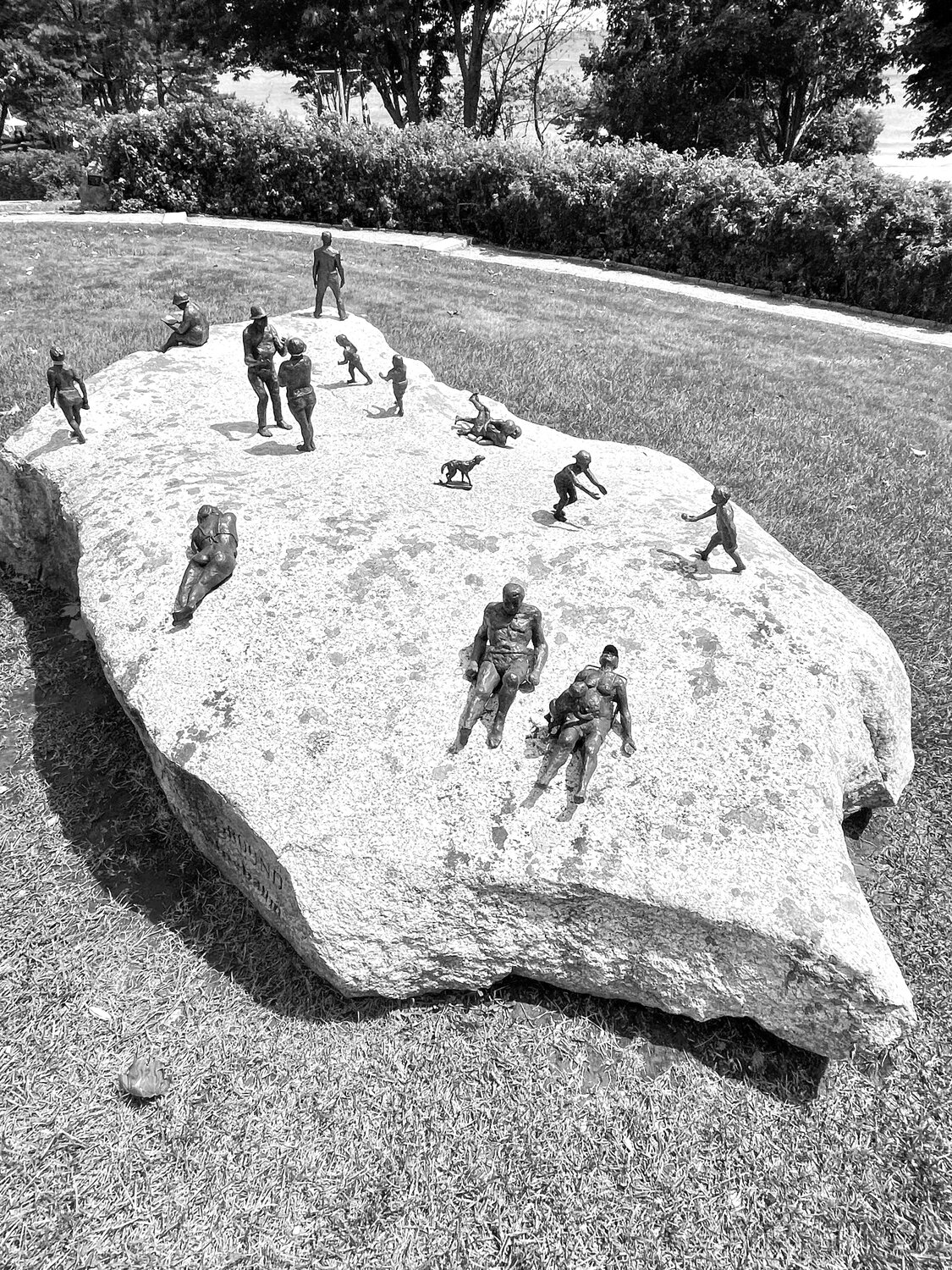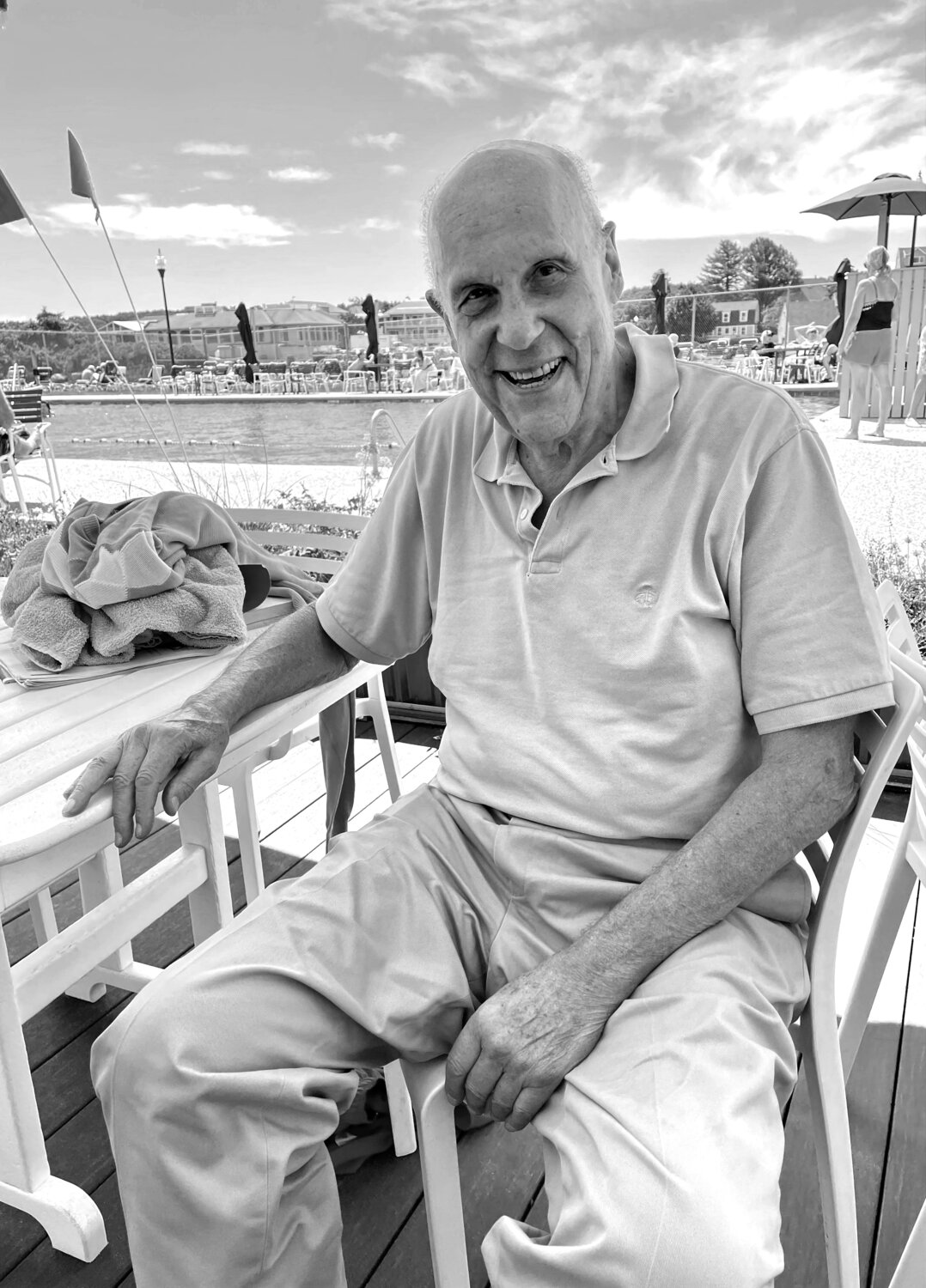Two benefactors at the beach
For 30 years, Betsey and I have enjoyed spending a few days each summer at a beach town in southern Maine. Our kids grew up visiting this enclave, and now both our grandkids have begun to feel at home there. Though only a few hours’ drive from Providence, it feels like a world away.
What do I like most about this idyllic spot? The views of the ocean, a nearby river or a small marina? The breezes and stars? The surf is usually too cold for me to jump in, but I love walking along the shore, listening to the roar of the waves and watching everybody enjoy a marvelous time.
Although I usually drive by the town’s oceanside bluff, I occasionally stop for a closer look. Inside a public park rests an unusual sculpture: a low-lying slab of stone on which are perched 15 metal figures of frolicking adults, children and a pooch – none more than a foot tall. As carved in its base, this sculpture is appropriately titled “Pleasure Ground.”
Obviously the creation of an amateur artist, he or she had only begun to learn how to portray humans and organize a composition.
Betsey and I happen to be quite serious fans of folk art from many corners of the world, and have collected scores of examples. Thus, we know that “Pleasure Ground” doesn’t properly fit within this rubric.
Some viewers may notice the sculptor’s name, which is carved into the stone’s base. Perhaps some locals knew or have heard of Sumner Winebaum. His name is also displayed elsewhere in the park; a plaque shows that he was one of only a half-dozen donors who helped establish or maintain it.
Before moving to Rhode Island 36 years ago, I had never heard of or met a Sumner. But my in-laws, in Massachusetts, have known three or four. And all these men just happened to be Jews! Of course, Sumner Redstone, the late media tycoon, was from Boston.
Wanting to learn more about Sumner Winebaum, I found an abundance of information on the internet. A son of Russian-born immigrants, Harry and Mollie Winebaum, Sumner was born in 1928 and reared in Portsmouth, New Hampshire. After graduating from the University of Michigan, he began his advertising career as a copywriter at Young & Rubicam, in New York City. He soon married Helen Auerbach, an actress, and took art classes at the Art Students League.
During the 1960s, Sumner opened Y&R offices in Europe, but in 1967 he returned with his young family to Portsmouth, where he took over Winebaum News, his father’s newspaper-distribution business.
After retiring in 1994, Sumner continued to enjoy many sports and helped lead numerous philanthropic organizations, including Temple Israel, a Conservative congregation in Portsmouth; Strawberry Banke Museum, only a few blocks away; and the New Hampshire Charitable Foundation. He passed away four years ago.
I had in fact once found another example of Sumner’s innocent artistry: two large bronze hands, perhaps resembling a Holocaust memorial, which can also – surprisingly – function as a menorah, on the grounds of Temple Israel.
There’s a wonderful outdoor pool at my family’s Maine hideaway where hotel guests and condo owners congregate. Betsey and I recognize more than a few of these people, which may include a tiny number of Jews. Nevertheless, I feel free to strike up a conversation with just about anybody.
This past August, I noticed an elderly gentleman (older than I!), who was wearing a baseball cap adorned with the number “53.” Somehow, I deduced that he had graduated from college that year and had recently attended his reunion.
I was right, so Leonard Milberg and I began to get acquainted. Indeed, I was soon introduced to his wife, Ellen, and the three of us chatted at length on two more occasions. Why? We love to yak, and we shared so many interests.
Now about 92, Leonard was one of only about 20 classmates able to attend his Princeton reunion. No doubt an even smaller number were able to attend their Class of 1949 reunion at Phillips Exeter Academy, in Exeter, New Hampshire.
I don’t know if any of these classmates was named Sumner, but there would have been a miniscule number of Jews. Yet, Leonard, whose family was from Brooklyn, New York, may have been the only Exeter freshman to lose $80 while playing his first game of poker!
Leonard’s father, Benjamin, initially a manufacturer of lingerie, became a factor, which meant financing production for other textile companies. Loving to speculate, he at one time owned – but later lost – 40 Thoroughbreds.
After serving in the Army during the Korean War and earning a master’s degree at Penn’s Wharton School, Leonard entered his father’s business. He accepted its leadership on the condition that his old man retire. Leonard is still working as a factor, and one of his sons also leads the company.
Though a trustee of the Brooklyn Art Museum for three decades, Leonard eventually made Princeton his primary cultural beneficiary. Indeed, he has established a gallery in its Firestone Library and endowed professorships, and he has also donated approximately 13,000 prints, drawings and books from his own extraordinary collection.
And this resident of Rye, New York, does like swimming. After diving into the hotel’s chilly pool, he challenged me to join him!
Did I mention that Leonard and I happen to resemble each other? He’s far taller, but his father was born in Romania, as was my paternal grandfather.
So now for the big question: given their fondness for philanthropy, as well as for this corner of Maine, did Sumner and Leonard ever meet? Wouldn’t they have enjoyed sunning and schmoozing?
GEORGE M. GOODWIN, of Providence, is the editor of Rhode Island Jewish Historical Notes.











